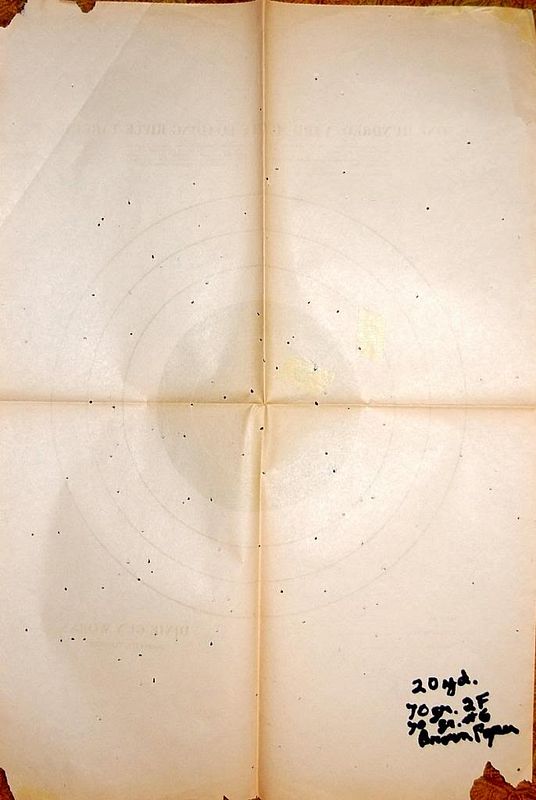I continue fooling around with wadding methods I find in original documents, and continue to have fun. I've previously reported on using both tow and "rubbed brown paper". The tow worked much better.
The paper wadding, which is just two layers of brown grocery sack over powder and over shot:

This was obviously a low pressure, low velocity load, and not impressive for density or evenness.
The tow wadding

This pattern is better, is consistent on the patterning board, and I have used it in the field, taken several squirrels and a couple of rabbits with it.
I had the idea to combine the two on a squirrel hunt yesterday. I loaded the powder, then the paper wad, then the tow overpowder wad, shot and then the overshot tow. I hadn't patterned this combination, but made a clean kill on a gray squirrel at what I estimated to be closer to 25 yards than to 20. After the hunt I decided to pattern my remaining load. Hadn't planned on that ahead of time, so all I could find to shoot at was a sheet of newspaper, sorry 'bout that. I was pleased to see what appears to be a more even and dense pattern at 25 yards than I had gotten with either of the two separately at 20. I'm going to be trying this some more, film at eleven.

This one was shot at 25 yards. (I touched each hole with a Sharpie so you can see them amongst all the clutter.) I aimed at the pineapple, and juice flew everywhere. :grin: I think this may give a better seal than the tow alone, keep the gasses from blowing through the shot a little better.
All patterns were shot with my 20 ga. smooth rifle, 46" barrel, using 70 gr. 2F Goex, 70 gr. equivalent #6 shot.
Spence
The paper wadding, which is just two layers of brown grocery sack over powder and over shot:

This was obviously a low pressure, low velocity load, and not impressive for density or evenness.
The tow wadding

This pattern is better, is consistent on the patterning board, and I have used it in the field, taken several squirrels and a couple of rabbits with it.
I had the idea to combine the two on a squirrel hunt yesterday. I loaded the powder, then the paper wad, then the tow overpowder wad, shot and then the overshot tow. I hadn't patterned this combination, but made a clean kill on a gray squirrel at what I estimated to be closer to 25 yards than to 20. After the hunt I decided to pattern my remaining load. Hadn't planned on that ahead of time, so all I could find to shoot at was a sheet of newspaper, sorry 'bout that. I was pleased to see what appears to be a more even and dense pattern at 25 yards than I had gotten with either of the two separately at 20. I'm going to be trying this some more, film at eleven.

This one was shot at 25 yards. (I touched each hole with a Sharpie so you can see them amongst all the clutter.) I aimed at the pineapple, and juice flew everywhere. :grin: I think this may give a better seal than the tow alone, keep the gasses from blowing through the shot a little better.
All patterns were shot with my 20 ga. smooth rifle, 46" barrel, using 70 gr. 2F Goex, 70 gr. equivalent #6 shot.
Spence





